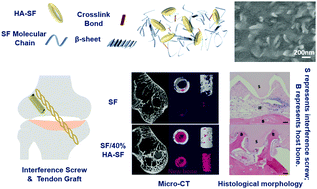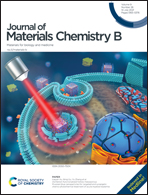An interference screw made using a silk fibroin-based bulk material with high content of hydroxyapatite for anterior cruciate ligament reconstruction in a rabbit model†
Abstract
Upgradation is still in need for the clinically applied interference screws in anterior cruciate ligament reconstruction for more reliable fixation. Silk fibroin bulk materials offer a promising opportunity for this application except lacking osteoinductivity to some extent. Here we report a novel silk-based bulk material with high content of hydroxyapatite–silk fibroin (HA–SF) hybrid particles, which is prepared via a dual-network hydrogel. This composite bulk material possesses a compression modulus of 3.2 GPa, comparable to that of the natural compact bone, and presents satisfactory cytocompatibility and osteoinductivity in vitro when combined with the HA–SF nanoparticles particularly. This composite bulk material shaped into interference screws exhibits remarkable biomechanical properties and significant new-bone ingrowth in the host bone tunnel in a rabbit anterior cruciate ligament reconstruction (ACLR) model at 4 weeks and 12 weeks post-operatively. Moreover, considering that this “hydrogel method” allows the material to be formed in a mold, avoiding complicated post fabrication, it is a potential candidate for clinical translation.



 Please wait while we load your content...
Please wait while we load your content...